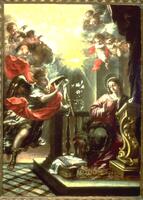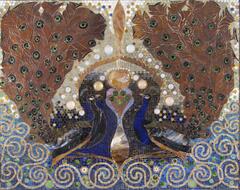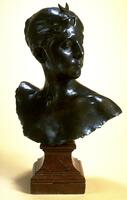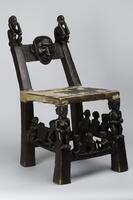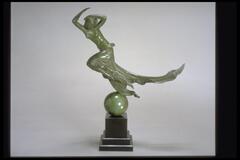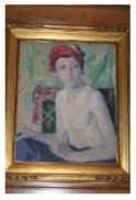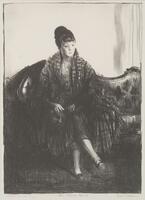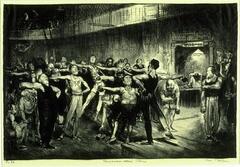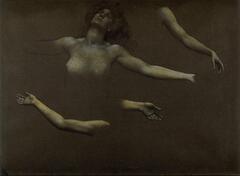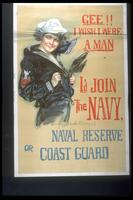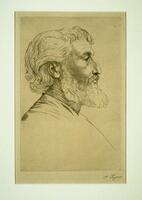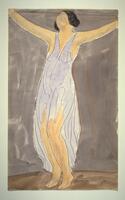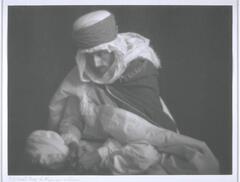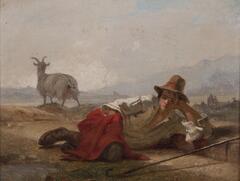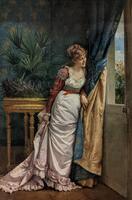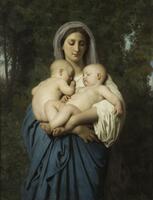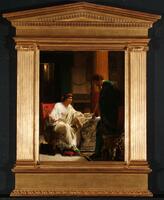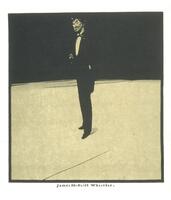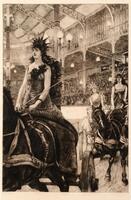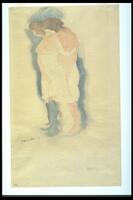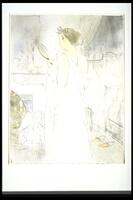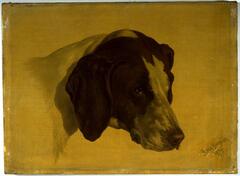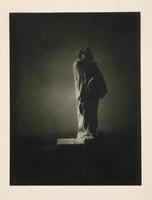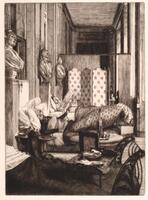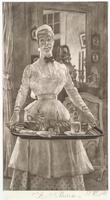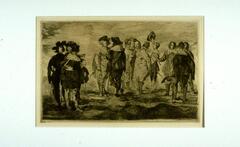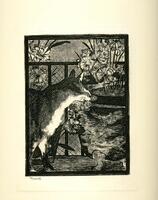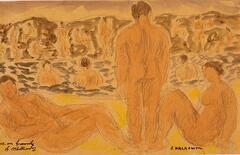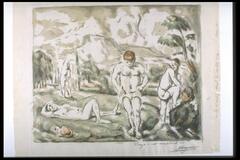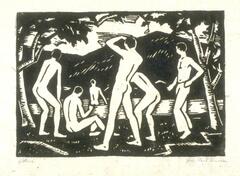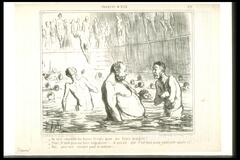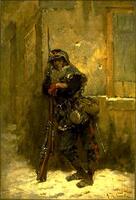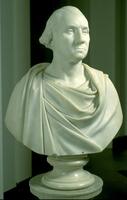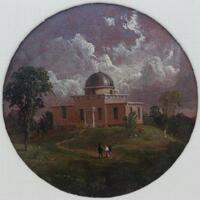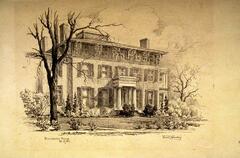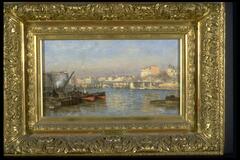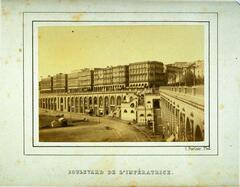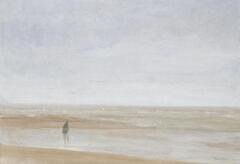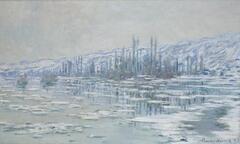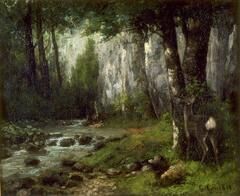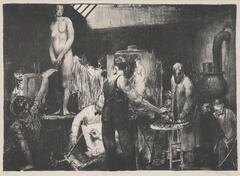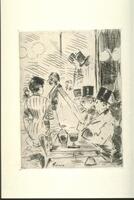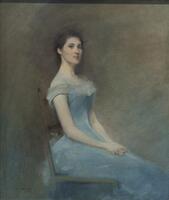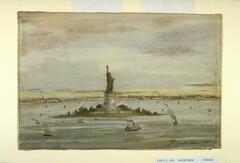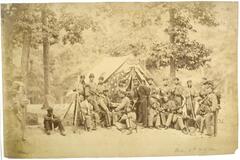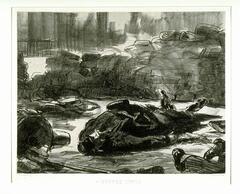Includes listings of all materials included in scavenger hunt.
6 Items in this Learning Collection
Collection Object
Collection Object
Collection Object
Collection Object
Collection Object
Copyright
All Rights Reserved
()
Bust of Diana
Accession Number
1986/2.83
Title
Bust of Diana
Artist(s)
Jean-Alexandre-Joseph Falguière
Object Creation Date
circa 1882
Medium & Support
bronze with marble base
Dimensions
23 1/16 in x 15 3/4 in x 11 in (58.58 cm x 40.01 cm x 27.94 cm);23 1/16 in x 15 3/4 in x 11 in (58.58 cm x 40.01 cm x 27.94 cm)
Credit Line
Gift of Dr. and Mrs. Coleman Mopper
Label copy
March 28 2009
This bust of Diana, the Roman goddess of the hunt, was one of the most successful ideal heads executed during the second half of the nineteenth century. It is excerpted from a full-length version of the subject exhibited to great acclaim at the Paris Salons of 1882 and 1887. Falguière capitalized on the popularity of this sculpture by excerpting the bust from the original and having it produced in bronze; the bust was available at lower cost and so could be marketed to a broader public. In the full-length sculpture Diana prepares to shoot an arrow, her right arm raised gracefully above her head and her left arm, grasping a bow, held down by her leg. Her striking, almost disdainful, downcast gaze was originally directed toward her prey. The only remaining indicator of Diana’s identity on the bust is the half moon that appears incongruously on her head; the goddess was associated with wild animals, the woodlands, and the moon. She was also an emblem of chastity, and a very popular subject on that account. It is characteristic of Falguière’s style that he does not idealize the deity by imposing classical proportions on her face but instead gives a sense of its distinctive features.
Subject matter
It is unclear whether this bust was first conceived as a study for Falguiere's full-length sculpture of Diana or as a spin-off to capitalize on the popularity of the finished statue. Regardless, Falguiere’s “Bust of Diana” was so popular at the end of the 19th century that many versions were made in at least three sizes and in different types of media, including marble and bronze. The bust would have appealed to its 19th century audience for its portrait-like realism, arresting pose, idealized beauty and Classical subject matter. In Roman mythology, Diana was goddess of the hunt and personification of the moon represented by the crescent atop her head. Abstracted from the context of the full-length statue in which her right arm is raised while her left holds a bow, Diana’s lowered eyelids and turned head give her an austere, slightly haughty appearance.
Physical Description
Bust-length figure of a woman with head turned proper left, down-turned eyelids and crescent moon atop head; executed in bronze with a rich, dark patina on a brownish stone base.
Primary Object Classification
Sculpture
Primary Object Type
casting
Additional Object Classification(s)
Sculpture
Collection Area
Western
Rights
If you are interested in using an image for a publication, please visit http://umma.umich.edu/request-image for more information and to fill out the online Image Rights and Reproductions Request Form.
Keywords
Diana
Portraits
bust
busts (figures)
literary theory
women (female humans)
1986/2.83
Title
Bust of Diana
Artist(s)
Jean-Alexandre-Joseph Falguière
Object Creation Date
circa 1882
Medium & Support
bronze with marble base
Dimensions
23 1/16 in x 15 3/4 in x 11 in (58.58 cm x 40.01 cm x 27.94 cm);23 1/16 in x 15 3/4 in x 11 in (58.58 cm x 40.01 cm x 27.94 cm)
Credit Line
Gift of Dr. and Mrs. Coleman Mopper
Label copy
March 28 2009
This bust of Diana, the Roman goddess of the hunt, was one of the most successful ideal heads executed during the second half of the nineteenth century. It is excerpted from a full-length version of the subject exhibited to great acclaim at the Paris Salons of 1882 and 1887. Falguière capitalized on the popularity of this sculpture by excerpting the bust from the original and having it produced in bronze; the bust was available at lower cost and so could be marketed to a broader public. In the full-length sculpture Diana prepares to shoot an arrow, her right arm raised gracefully above her head and her left arm, grasping a bow, held down by her leg. Her striking, almost disdainful, downcast gaze was originally directed toward her prey. The only remaining indicator of Diana’s identity on the bust is the half moon that appears incongruously on her head; the goddess was associated with wild animals, the woodlands, and the moon. She was also an emblem of chastity, and a very popular subject on that account. It is characteristic of Falguière’s style that he does not idealize the deity by imposing classical proportions on her face but instead gives a sense of its distinctive features.
Subject matter
It is unclear whether this bust was first conceived as a study for Falguiere's full-length sculpture of Diana or as a spin-off to capitalize on the popularity of the finished statue. Regardless, Falguiere’s “Bust of Diana” was so popular at the end of the 19th century that many versions were made in at least three sizes and in different types of media, including marble and bronze. The bust would have appealed to its 19th century audience for its portrait-like realism, arresting pose, idealized beauty and Classical subject matter. In Roman mythology, Diana was goddess of the hunt and personification of the moon represented by the crescent atop her head. Abstracted from the context of the full-length statue in which her right arm is raised while her left holds a bow, Diana’s lowered eyelids and turned head give her an austere, slightly haughty appearance.
Physical Description
Bust-length figure of a woman with head turned proper left, down-turned eyelids and crescent moon atop head; executed in bronze with a rich, dark patina on a brownish stone base.
Primary Object Classification
Sculpture
Primary Object Type
casting
Additional Object Classification(s)
Sculpture
Collection Area
Western
Rights
If you are interested in using an image for a publication, please visit http://umma.umich.edu/request-image for more information and to fill out the online Image Rights and Reproductions Request Form.
Keywords
Diana
Portraits
bust
busts (figures)
literary theory
women (female humans)
